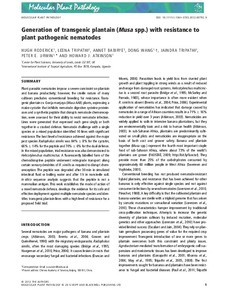| dc.contributor.author | Roderick, H. |
| dc.contributor.author | Tripathi, L. |
| dc.contributor.author | Babirye, A. |
| dc.contributor.author | Wang, D. |
| dc.contributor.author | Tripathi, J.N. |
| dc.contributor.author | Urwin, P.E. |
| dc.contributor.author | Atkinson, H.J. |
| dc.date.accessioned | 2019-12-04T11:04:23Z |
| dc.date.available | 2019-12-04T11:04:23Z |
| dc.date.issued | 2012-03 |
| dc.identifier.citation | Roderick, H., Tripathi, L., Babirye, A., Wang, D., Tripathi, J., Urwin, P.E. & Atkinson, H.J. (2012). Generation of transgenic plantain (Musa spp.) with resistance to plant pathogenic nematodes. Molecular Plant Pathology, 13(8), 842-851. |
| dc.identifier.issn | 1464-6722 |
| dc.identifier.uri | https://hdl.handle.net/20.500.12478/1416 |
| dc.description.abstract | Plant parasitic nematodes impose a severe constraint on plantain and banana productivity; however, the sterile nature of many cultivars precludes conventional breeding for resistance. Transgenic plantain cv. Gonja manjaya (Musa AAB) plants, expressing a maize cystatin that inhibits nematode digestive cysteine proteinases and a synthetic peptide that disrupts nematode chemoreception, were assessed for their ability to resist nematode infection. Lines were generated that expressed each gene singly or both together in a stacked defence. Nematode challenge with a single species or a mixed population identified 10 lines with significant resistance. The best level of resistance achieved against the major pest species Radopholus similis was 84% ± 8% for the cystatin, 66% ± 14% for the peptide and 70% ± 6% for the dual defence. In the mixed population, trial resistance was also demonstrated to Helicotylenchus multicinctus. A fluorescently labelled form of the chemodisruptive peptide underwent retrograde transport along certain sensory dendrites of R. similis as required to disrupt chemoreception. The peptide was degraded after 30 min in simulated intestinal fluid or boiling water and after 1 h in nonsterile soil. In silico sequence analysis suggests that the peptide is not a mammalian antigen. This work establishes the mode of action of a novel nematode defence, develops the evidence for its safe and effective deployment against multiple nematode species and identifies transgenic plantain lines with a high level of resistance for a proposed field trial. |
| dc.description.sponsorship | Biotechnology and Biological Sciences Research Council, United Kingdom |
| dc.description.sponsorship | Department for International Development, United Kingdom |
| dc.format.extent | 842-851 |
| dc.language.iso | en |
| dc.subject | Transgenic |
| dc.subject | Plantains |
| dc.subject | Resistance |
| dc.subject | Plant |
| dc.subject | Pathogens |
| dc.subject | Nematodes |
| dc.title | Generation of transgenic plantain (Musa spp.) with resistance to plant pathogenic nematodes |
| dc.type | Journal Article |
| dc.description.version | Peer Review |
| cg.contributor.crp | Roots, Tubers and Bananas |
| cg.contributor.affiliation | University of Leeds |
| cg.contributor.affiliation | International Institute of Tropical Agriculture |
| cg.coverage.region | Africa |
| cg.coverage.region | East Africa |
| cg.coverage.country | Uganda |
| cg.isijournal | ISI Journal |
| cg.authorship.types | CGIAR and advanced research institute |
| cg.iitasubject | Plantain |
| cg.journal | Molecular Plant Pathology |
| cg.howpublished | Formally Published |
| cg.accessibilitystatus | Limited Access |
| local.dspaceid | 79557 |
| cg.identifier.doi | https://dx.doi.org/10.1111/j.1364-3703.2012.00792.x |

